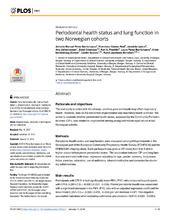Periodontal Health status and lung function in two Norwegian cohorts
Perez Barrionuevo, Antonio Manuel; Gomez Real, Francisco; Igland, Jannicke; Johannessen, Ane; Omenaas, Ernst; Franklin, Karl A.; Barrionuevo, Laura Perez; Åstrøm, Anne Nordrehaug; Svanes, Cecilie; Bertelsen, Randi Jacobsen
Peer reviewed, Journal article
Published version

Åpne
Permanent lenke
https://hdl.handle.net/1956/19810Utgivelsesdato
2018-01-19Metadata
Vis full innførselSamlinger
Originalversjon
https://doi.org/10.1371/journal.pone.0191410Sammendrag
Rationale and objectives: The oral cavity is united with the airways, and thus poor oral health may affect respiratory health. However, data on the interaction of periodontal and respiratory health is limited. We aimed to evaluate whether periodontal health status, assessed by the Community Periodontal Index (CPI), was related to lung function among young and middle-aged adults in two Norwegian cohorts. Methods: Periodontal health status and lung function were measured among 656 participants in the Norwegian part of the European Community Respiratory Health Survey (ECHRS III) and the RHINESSA offspring study. Each participant was given a CPI-index from 0 to 4 where higher values reflect poorer periodontal status. The association between CPI and lung function was estimated with linear regression adjusting for age, gender, smoking, body mass index, exercise, education, use of antibiotics, inhaled medication and corrected for clustering within families. Main results: Participants with CPI 3–4 had significantly lower FEV1/FVC ratio compared to participants with CPI 0, b (95% CI) = -0.032 (-0.055, -0.009). Poorer periodontal health was associated with a significant decrease in the FEV1/FVC ratio with an adjusted regression coefficient for linear trend b (95% CI) = -0.009 (-0.015, -0.004) per unit increase in CPI. This negative association remained when excluding asthmatics and smokers (-0.014 (-0.022, -0,006)). Conclusions: Poorer periodontal health was associated with increasing airways obstruction in a relatively young, healthy population. The oral cavity is united with the airways and our findings indicate an opportunity to influence respiratory health by improving oral health.
